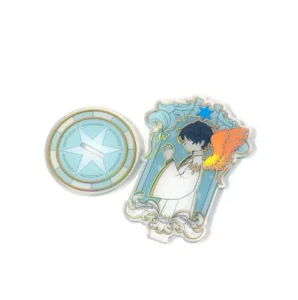Most likely, you have definitely wondered what the world of game art looks like behind the scenes? It is definitely about something more than just special effects and the brilliance of models. “Behind the scenes” is the daily painstaking work of the entire team. Artists who are part of outsourcing studios, in fact, “give birth” to characters, their surroundings, various animations and other important visual details, which then come to life in full-fledged game products. Each of their working days is a so-called mixed cocktail of ingredients such as creativity, precision in technological matters and coordination and communication with clients from different parts of the world. In this article, we will consider the story of Max — a 3D artist from the Ukrainian company N-iX Games — as a typical example of what the everyday life of a specialist in the field of art outsourcing companies looks like.
Morning: First strokes on the canvas of collaboration
At approximately 8:45, Max opens his laptop and begins his productive professional day. Using one of the video platforms, he joins the team’s daily online meeting, during which the art director actively discusses the client’s deadline, and the team receives specific guides and concepts for this project. After all, the foundation of any successful product is based on 3 “whales”: clear technical documentation, style guide, and references.
It is worth noting that customer companies (in particular, from AAA projects) most often provide concept art from their home office, and outsourcing studios prepare ready-made 3D models, animations and textures. This is how most leading art outsourcing companies work: an external studio must exactly match the client’s vision, adhere to technical requirements, avoiding completely unnecessary and unnecessary rework.
First change: A new scene in the frame
When the clock already shows about 10:15, Max moves on to the production session. Today, his main task is to develop a 3D model of the character, which includes:
- detailed face
- clothes
- armor
Our hero works in ZBrush, Substance Painter and Maya. The references are both quite complex and stylized. Such a scene completely and completely corresponded to the concept that the client sent in advance.
In the so-called joint symphony with Max, a technical artist, a producer and an art director also work. And they all work together in one studio, for example, in N-iX Games. This company has about 200 3D artists in its arsenal and provides a full-fledged art production cycle at a really high level of quality.
Lunch: Sharing experiences and inspiration
Around 1:00 PM, colleagues decide to go for a coffee break. During the lunch break, the team actively discusses different variations of style: some people prefer photorealism, while others are more inspired by the cartoon style. Artists from the digital world share new brush packs, plugins, and thoughts on current trends that are quite often ordered from art outsourcing companies today:
- low-poly for mobile
- stylized fantasy art
- or the same style of “cartoon realism”
After lunch: Creative routine
Sometime after 2:00 PM, Max returns to work tasks. He applies texturing, retouches UV maps, and adds various visual details. In addition, as a true professional in his field, he closely monitors the polygonal budget and optimization. After all, each of the resources must fully and completely meet all the technical requirements of Unreal Engine or Unity. This is a “classic” for art outsourcing companies that must integrate resources into the game engine without loss of quality.
At 4:00 PM, a regular online review meeting begins with a representative or representatives of the customer team. The client carefully checks the first renders — reads whether they correspond to the style, whether anything goes beyond the technical guide. Max, in turn, makes certain corrections if necessary (for example, add a pattern on the fabric or make the metal a little lighter).
The hardest part is finding the balance
About an hour after the online meeting with the client, Max continues to work on textures, keeping in mind that the artistic approach should remain both creative and technically accurate. This is a requirement often made by producers for teams working at companies like N‑iX Games. After all, stylistic consistency at all stages of art production is important, especially when it comes to ready-to-integrate 3D assets.
Evening: Fine-tuning and export
At 6:30 PM, Max’s workday comes to an end, and he completes the final static scene, which includes such details as the character’s perspective, shaders in Unreal, lighting and a few more moments. Having implemented the preliminary render, Max exports the .fbx file, connecting this file directly to the game engine. Next, the 3D artist checks how this file looks in real game conditions.
Export is the final stage during which the artifact becomes a game asset. At this stage, edits already cost a lot of time, which is why the artist must be one hundred percent accurate in every, even the smallest, detail.
Reflection: What Makes the Heart Beat
Before the final completion of all the workflows for the day, Max closes and checks the result directly in the engine: the character is standing, detailed, the light works, the textures look clean and harmonious. Max writes a short letter or message to the producer, in which he informs that the scene has been successfully exported, everything has been clearly checked in Unreal and is ready for full integration. And here comes the moment of satisfaction, because the master finally sees the final product that he was able to create in collaboration with other representatives of his art outsourcing company.
Advantages of this format for the artist
- A large pool of various variations of projects: it all depends on the needs of each new client: characters, environments, UI design details, and so on.
- Active development of skills in compliance with technical standards, because a 3D artist works with real engine constraints in real time.
- Quite rapid career growth and multiplication of valuable and interesting cases for the portfolio, because in a fairly short period of time you can collect a lot of cool game cases.
Summary
The working day turned out to be as full as possible: a strategic session with the internal team, modeling, texturing, review, a series of edits, integration, and final export. But it is this sequence — pixel (detailing), brush (creativity), and export (integration) — that is fundamental for an artist from an art outsourcing studio. This beautiful and clear system is a symbiosis of artistic freedom with client requirements, a cocktail of team synergy with deadlines, and technical discipline with creativity.













